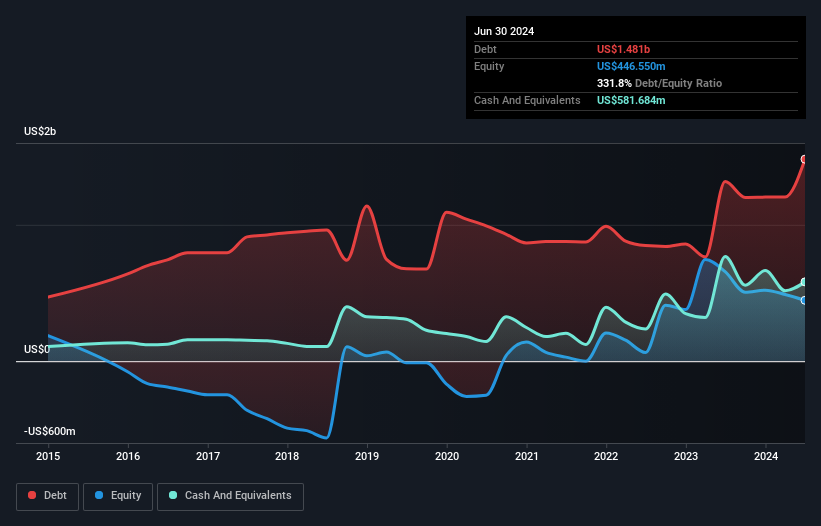Legendary fund manager Li Lu (who Charlie Munger backed) once said, 'The biggest investment risk is not the volatility of prices, but whether you will suffer a permanent loss of capital.' So it seems the smart money knows that debt - which is usually involved in bankruptcies - is a very important factor, when you assess how risky a company is. As with many other companies Bloom Energy Corporation (NYSE:BE) makes use of debt. But the more important question is: how much risk is that debt creating?
What Risk Does Debt Bring?
Debt is a tool to help businesses grow, but if a business is incapable of paying off its lenders, then it exists at their mercy. Part and parcel of capitalism is the process of 'creative destruction' where failed businesses are mercilessly liquidated by their bankers. While that is not too common, we often do see indebted companies permanently diluting shareholders because lenders force them to raise capital at a distressed price. Of course, plenty of companies use debt to fund growth, without any negative consequences. The first step when considering a company's debt levels is to consider its cash and debt together.
View our latest analysis for Bloom Energy
What Is Bloom Energy's Debt?
The image below, which you can click on for greater detail, shows that at June 2024 Bloom Energy had debt of US$1.48b, up from US$1.32b in one year. However, it does have US$581.7m in cash offsetting this, leading to net debt of about US$899.8m.

A Look At Bloom Energy's Liabilities
We can see from the most recent balance sheet that Bloom Energy had liabilities of US$393.5m falling due within a year, and liabilities of US$1.71b due beyond that. Offsetting these obligations, it had cash of US$581.7m as well as receivables valued at US$626.7m due within 12 months. So its liabilities outweigh the sum of its cash and (near-term) receivables by US$893.1m.
Bloom Energy has a market capitalization of US$2.32b, so it could very likely raise cash to ameliorate its balance sheet, if the need arose. But we definitely want to keep our eyes open to indications that its debt is bringing too much risk. The balance sheet is clearly the area to focus on when you are analysing debt. But it is future earnings, more than anything, that will determine Bloom Energy's ability to maintain a healthy balance sheet going forward. So if you're focused on the future you can check out this free report showing analyst profit forecasts.
In the last year Bloom Energy's revenue was pretty flat, and it made a negative EBIT. While that's not too bad, we'd prefer see growth.
Caveat Emptor
Importantly, Bloom Energy had an earnings before interest and tax (EBIT) loss over the last year. To be specific the EBIT loss came in at US$39m. Considering that alongside the liabilities mentioned above does not give us much confidence that company should be using so much debt. Quite frankly we think the balance sheet is far from match-fit, although it could be improved with time. However, it doesn't help that it burned through US$405m of cash over the last year. So suffice it to say we consider the stock very risky. For riskier companies like Bloom Energy I always like to keep an eye on whether insiders are buying or selling. So click here if you want to find out for yourself.
When all is said and done, sometimes its easier to focus on companies that don't even need debt. Readers can access a list of growth stocks with zero net debt 100% free, right now.
Valuation is complex, but we're here to simplify it.
Discover if Bloom Energy might be undervalued or overvalued with our detailed analysis, featuring fair value estimates, potential risks, dividends, insider trades, and its financial condition.
Access Free AnalysisHave feedback on this article? Concerned about the content? Get in touch with us directly. Alternatively, email editorial-team (at) simplywallst.com.
This article by Simply Wall St is general in nature. We provide commentary based on historical data and analyst forecasts only using an unbiased methodology and our articles are not intended to be financial advice. It does not constitute a recommendation to buy or sell any stock, and does not take account of your objectives, or your financial situation. We aim to bring you long-term focused analysis driven by fundamental data. Note that our analysis may not factor in the latest price-sensitive company announcements or qualitative material. Simply Wall St has no position in any stocks mentioned.
About NYSE:BE
Bloom Energy
Designs, manufactures, sells, and installs solid-oxide fuel cell systems for on-site power generation in the United States and internationally.
Exceptional growth potential with slight risk.
Similar Companies
Market Insights
Community Narratives




